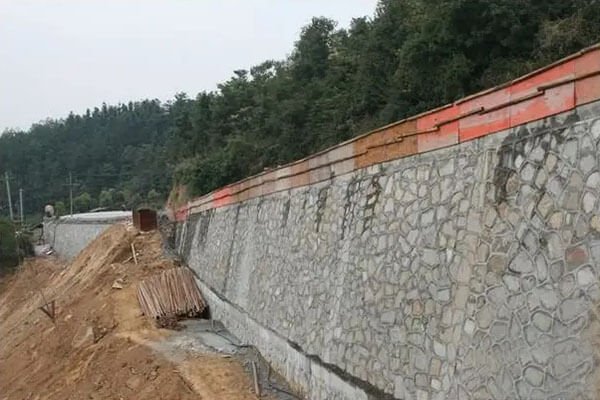A highway retaining wall is a structure used to support the roadbed fill or cutting soil, stabilize it, and prevent it from slipping. The more common retaining walls are gravity type, counterweight type, cantilever type, arm type, reinforced soil type, anchor rod type, anchor plate type, etc. In addition, there are new forms such as vertical prestressed bolt type, soil nail type, and pile plate type.
The soil-nailed retaining wall is a new type of retaining wall structure, which consists of reinforced soil, soil nails placed in the soil, protective panels, and a drainage system. The natural soil is reinforced in situ by soil nails and combined with the shotcrete faceplate to form a gravity retaining wall, which resists the earth pressure and other forces behind the wall, thereby stabilizing the excavation slope. The soil nail forms a composite body by relying on the cohesive force, frictional resistance, and surrounding soil at the interface with the soil body. The soil nails are passively stressed under the condition that the soil body is deformed, and the soil body is reinforced through its tension. The deformation of the soil between the soil nails is restrained by the protective plate.

Types of Soil Nails in Soil Nailed Walls
There are several types of drilling grouting nails, driving nails, grouting driving nails, and high-pressure jetting nails. Among them, drilling grouting nails are the most commonly used type.
The Construction Process of Soil Nail Wall
Excavation: The depth should be controlled between 1 ~ 2 m depending on the soil properties of different properties. It can be as small as 1 m in the saturated cohesive soil and 2 m in dry hard cohesive soil.
Install soil nails: Drill holes, set up a row of soil nails (that is, insert a row of steel bars or anchors), set up drainage pipes, and grout, arrange steel mesh, and spray concrete.
Similarities and Differences Between Soil Nail Wall and Anchor Retaining Wall
Soil nailing is an in-situ reinforcement technology, that is, a geotechnical reinforcement method that improves the mechanical properties of the soil by laying tie bars in the soil.
The anchor retaining wall can choose whether to apply prestress or not. Generally, the soil nail type retaining wall does not apply prestress. It is required that after the soil body undergoes slight deformation, the soil nails are passively subjected to wear resistance and formed together with the original unstable soil body, forming a stable soil mass similar to the specific self-supporting capacity of a gravity retaining wall.
Advantages and Disadvantages of Soil Nailing Retaining Walls
- The construction equipment is light and the operation method is simple;
- The construction does not occupy the site alone;
- The construction speed is fast;
- Simple structure and low cost;
- If self-drilling soil nails are used, grouting and anchoring can be completed in one drilling. No casing is required for construction in soft soil, loose sandy soil, and other difficult-to-form geological structures, and the construction efficiency is high.
The soil nail wall is a soil retaining system formed by reinforced rods and protective panels set in the natural slope or the slope formed by excavation. It is used to improve the in-situ soil and work together with the in-situ soil to form a gravity Retaining wall-type light retaining structure, thereby improving the stability of the entire slope. Compared with other retaining walls, soil-nail walls have unique advantages.